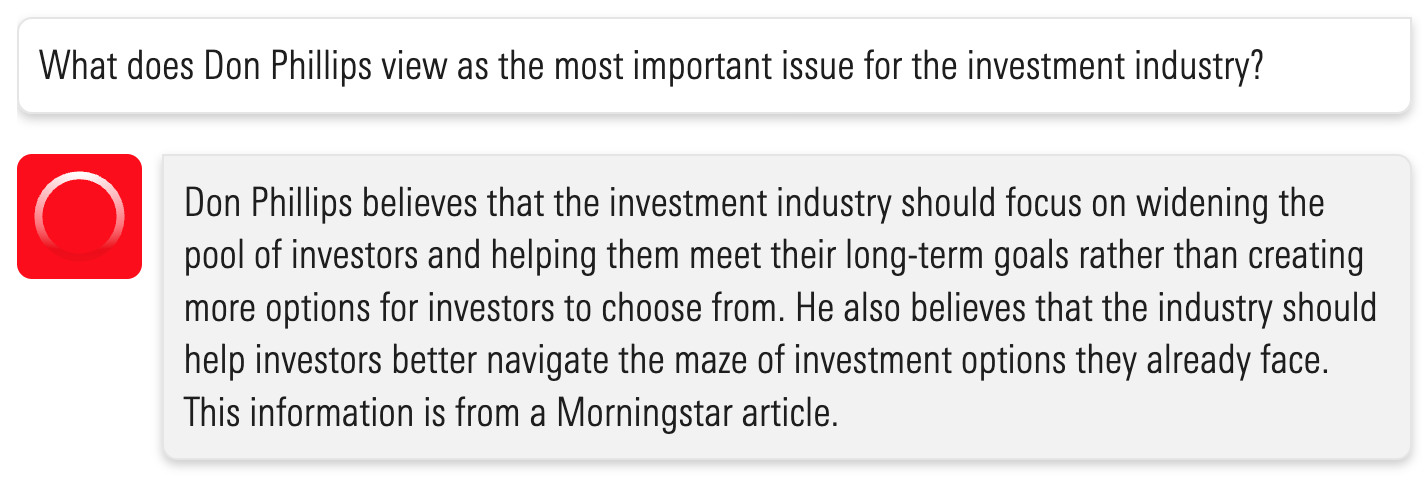Could AI Actually Make Investing Less Confusing?
Morningstar’s new digital research assistant, Mo, says it could simplify investing, but AI isn’t a cure-all for its complexity.

I’m guessing that when Don Phillips, Morningstar’s first editor, started working at Morningstar in 1986, he couldn’t have imagined that his work would go from a print binder to a CD-ROM to a website and now into an artificial intelligence chatbot named Mo. (Get it? ‘Mo’rningstar …)
But here we are in 2023, launching the beta-test version of a digital research assistant built on the expertise of countless Morningstar analysts, including Don Phillips. Individual investors can access Mo through Morningstar Investor. Advisors and professionals can use it through Research Portal, which is also available in Direct or Advisor Workstation.
Mo draws on our extensive investment research and every article published on Morningstar.com since 2018. And for now, Mo is good at describing basic concepts of investing and defining what can sometimes be opaque financial terminology. It does quite well at explaining the advantages of investing in an index fund over a higher-cost actively managed fund; the benefits of using 529 plans for college savings; and what “duration risk” means. Mo isn’t ready to reliably provide accurate single data points or specific ratings … yet. An important note: Mo does not provide investment advice.
This is just the beginning for Mo and other AI-enabled applications Morningstar is thinking about. Our teams are committed to progressing this technology in a responsible and measured approach. I share many of the concerns around AI that our readers probably have and am glad to see Morningstar’s high degree of attention to privacy, security, and restrictions to ensure our customers are protected and have positive experiences. As more AI is brought into investing workflows, it will be important that investors stay vigilant with their concerns. Long term, I see huge potential for AI acting as a companion for investors and advisors to help sift through information and navigate various investing tasks.
Loaded With Morningstar’s Research
In my role, I have the privilege of talking with many individuals about investing, and the idea of investing being a lifelong learning journey comes up often. The number of concepts, terms, theories, strategies, practices, and rules that must be understood and then ultimately practiced to be a successful investor is staggering. Helping people with this learning journey is a big part of what we do every day on Morningstar.com.
Recent examples include a review of the classic 60/40 portfolio, a look inside direct indexing, an explanation of how ETFs use security lending to generate income, describing how well buy and hold investing has done, and what you need to know about fund capital gains distributions. It takes our experts hundreds and sometimes thousands of words to unpack and illustrate these topics. On the topic of direct indexing, it took 40 minutes of podcast conversation between three experts! And most of these articles are written for an audience with intermediate and above investing knowledge.
We’re also bringing other AI-type algorithms to our Morningstar.com experience. Currently publishing are smart-text market updates that generate real-time insights and analysis on financial markets. These are unrelated to Mo but another form of automated insights. You can see the new Morningstar Stock Market Today section, which updates every five minutes, on our Markets hub. I encourage you to bookmark it and come back throughout the day for the latest updates.

A large portion of the U.S. population will need to rely in part or in whole on investments made in 401(k)s, IRAs, 529s, 403(b)s, and brokerage accounts to fund their financial goals. Yet, there are many barriers to understanding investing. Financial literacy is rising, and there are many resources now available, but it all still takes time, interest, and energy.
Advisors and digital advice solutions are a great way for individuals to find support, and roughly 40% of the U.S. population with investing accounts use an advisor in some capacity. Nonetheless, the industry needs to keep working to increase the number of investors. Don’t take just my word for it. Here’s Don’s view, according to Mo, on what is the most important issue for the investment industry.

I fact-checked this answer with Don Phillips himself, and he thought Mo’s response was right on. This answer took Mo seconds; it would have taken a person a fair amount of time reading Don’s catalog of articles to reach this response to my same prompt. Don did say he would probably expand and clarify Mo’s response: “Investors could use lots of tools that help them build better portfolios and stay disciplined. What they don’t need are scores of new, untested, and complicated fund types.”
Mo, in this example, is exhibiting the exciting potential of how large, language model-driven AI chatbots can break down vast quantities of information into easy-to-understand answers. But it is also showing one of the limitations of AI: a lack of original thought built upon experience and conviction. This is why we will continue our tradition of rigorous independent research and coverage of investing topics. Overall, I am optimistic that AI technologies will play a role in widening the pool of investors and provide better tools for building portfolios and reaching financial goals.
The author or authors do not own shares in any securities mentioned in this article. Find out about Morningstar’s editorial policies.


/cloudfront-us-east-1.images.arcpublishing.com/morningstar/JNGGL2QVKFA43PRVR44O6RYGEM.png)
/cloudfront-us-east-1.images.arcpublishing.com/morningstar/BC7NL2STP5HBHOC7VRD3P64GTU.png)